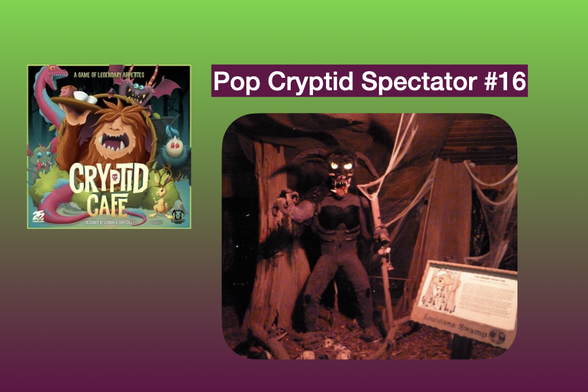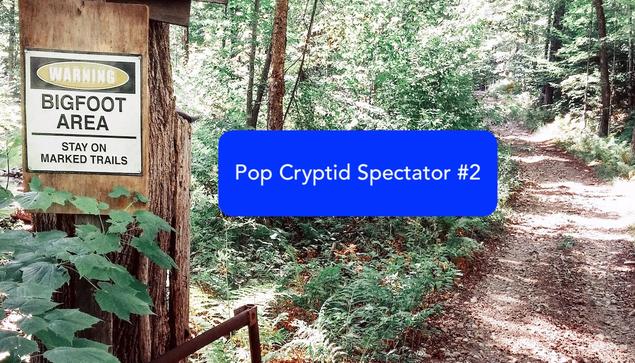Pop Cryptid Spectator 16
Hi there, and thanks for checking out PCS 16.
In this edition:
- Pop cryptid mainstreamification
- Cryptid festivals near you
- Cryptid Cafes
- Social media feed of cryptids
- Zoos with cryptid content
- Chaneque video debunked
Pop Cryptid mainstreamification
The Pop Cryptid idea is a very hard sell to the stalwart, traditional cryptid enthusiast – the person who still believes that we will discover a real-life Bigfoot someday and holds that the concept of cryptozoology deserves a scientific approach. As I’ve expressed in countless instances, that view is anachronistic compared to the modern version of cryptozoology, which is more about any mysterious creature or thing you can imagine. Modern online cryptids have little to do with zoology, except in speculative and fictional aspects. The evolution has happened online.
Prior to the 1990s, information about cryptids could be found in person, print, or on TV. Most importantly, cryptids are stories transmitted locally, directly from one person to another. The internet changed everything as “local” became almost meaningless. There were already a very few cryptids that were known nationally or worldwide – Bigfoot, Yeti, Nessie, Champ. But then came the late 1990s and cryptids became a worldwide sensation thanks to web pages, shared video, and social media. Without the Internet, you would not have the phenomena of the chupacabra, the Flatwoods monster, or the Fresno nightcrawler.
From there, the concept of local mystery monsters was embraced and shared. The reasons why it has become so popular and mainstream is a fascinating cultural story. I’ve already mentioned the festivals, the tourism tie-ins, the commodification, and the diversification of the cryptid scene, however, the traditional cryptozoology enthusiast ignores or rejects this. They insist that their version is the correct one that needs to be rehabilitated from the sensationalistic commercialism and separated from paranormalism.
I do not believe that will ever happen. I don’t think it can happen because zoological-based cryptozoology doesn’t make sense anymore. What may happen is that a certain niche area that treats cryptid lore as folk zoology will grow. In that sense, we’re talking about post-cryptid cryptozoology – not the discovery of new animals, but about the cultural aspects, interpretation, and meaning of strange animal encounters. That is an endlessly fruitful branch of this interesting tree!
Meanwhile, the number of festivals grows each year, the mainstreamification evolution of new cryptids continues, and the commodification becomes more lucrative.
Cryptid festivals near you
West Virginia is one of the top states in celebrating and popularizing their cryptids. The small towns of Point Pleasant, Flatwoods, Grafton, and Fairmont have their own famous monster festivals, and there are a few other WV cryptid fests that are more general.
According to my active list here, Ohio has the most cryptid festivals with 9, WV is second with 8, and Kentucky is third with 7. But, hey, I might be missing some! Excluding “conferences” but focusing on family-friendly fairs, conventions and town celebrations, let me know if I’m missing any in your state!
At the new three-day Oregon Mt. Hood Bigfoot festival in April, the local news reported that more than 800 people attended the lectures, visited the exhibitors and purchased merchandise from the vendors, boosting local tourism.
I regularly see organizers saying how they approach their town councils for event approvals. They often have to explain what a “cryptid” is and assure the chairpeople that this will be a big deal and big boost for a small town economy. Check out this article on how one cryptid festival in Ohio will continue in 2025 in a new location. Note that the organizer describes cryptids as “mythological”, not zoological, because it’s far easier to buy into a festival when you are free to play with the ideas and have fun.
On a side note, this is the second year I applied to be a speaker at Squonkapalooza in PA. But they seem to not want an expert in the subject of their own event – pop cryptids! They have not responded to my application.
The Cryptid Factor podcast will be at the super popular Edinburgh Fringe Festival this summer.
Cryptid Cafes
It’s one of my crazy dreams to have a cryptid-themed bistro with a gift shop. This idea is not unique and it’s spreading, both in real life and virtually. Here are some examples:
- The Rooster & The Crow has a Cryptid Den Bar and Lounge in Wilmington, NC.
- There is a Cryptid Cafe and shop in Moss, TN
- Mythical Pizza looks like a great spot: a cryptid themed, family-friendly pizza shop in Berkeley Springs, WV.
https://www.youtube.com/watch?v=CjnYKcqylLs
Berkeley Springs is a neat little town (with cool history and geology) that deserves some love. I’m sad that I missed Mythical Pizza, which I didn’t know about (or didn’t exist), the last time I was there about 2 years ago. It’s such a smart idea to appeal to West Virginia cryptids (even though it’s quite far from the cryptid hotspots). The video explains that it was the young family member who hit upon the idea.
In addition to brick and mortar establishments, there are some virtual cryptid cafe spots:
Cryptid Cafe is a board game where you are a lead server at the Sasquatch-owned restaurant packed with legendary creatures from all over the world. You’re aim is to gather food, filll orders, and earn the most tips to be crowned the most “legendary” server.
Cryptid Coffeehouse is a casual, slice-of-life virtual game about living in the American Midwest, meeting new people, and developing feelings for someone. It’s a game about relationships and the importance of consent, permission, and respect in those relationships, especially relationships that are between stages. It’s about being yourself.
https://www.youtube.com/watch?v=7q8Iymva1x8
Social media feed of cryptids
The best way to keep up with the ever-changing cryptid zoo is to check in with social media. The cutting edge stuff may be on Instagram but that app is not in my wheelhouse. And Xitter participation is completely out. But BlueSky has a stream of cryptid content that reveals some crucial characteristics of today’s pop cryptids. Here are some snapshots:
This Cryptid Crawl in Ohio encourages people to cosplay, patronize local business, and socialize with other cryptid fans. This event is an amazing way to support a small community and encourage inclusivity. Note the emphasis on queer acceptance – a HUGE component of cryptid culture. A “cryptid” is viewed as the shy and hidden “other”, a liminal being existing between two worlds, and pretty OK with their uniqueness.
Here’s a fun one:
What?! For those of you who find this use of “cryptid” cryptic, it is essential to understand the modern use of the world. Anything can be a cryptid if it is elusive, randomly appears or disappears, and has an aura of mystery and lore. Some people are lucky to find McRibs at their local McDs, and others can see no trace of it. Maybe you glimpsed one yesterday, but it’s like it never existed today. Get it?
With apologies to the cryptozoological purists, you are never going to squash this new usage of cryptid. It’s too darn convenient.
Social media #cryptid feeds have edgy original art, and portray people and animals as cryptids if they are photographed in weird circumstances or blurry. People call themselves cryptids if they are captured in an image at all because they deliberately avoid being seen.
Zoos with cryptid exhibits
At Halloween time, some zoos feature monster myths and spooky legends related to animals. I recently heard that the Audubon Zoo in Louisiana has (or had) an exhibit about the legends of local swamp monsters (Honey Island swamp monster, rougarou/loup garou, etc.). I haven’t seen it in person, but some commenters say it pokes fun at the belief of a monster in the swamps used to keep children in line.
This got me thinking about zoos, that people assume will provide straight zoological information, including mentions of rumored animals. The Audubon Zoo exhibit was installed in 2000 (perfectly timed with the pop cryptid explosion that began at this time). The info I saw regarding it was a few years old but the content seemed a bit off regarding the folklore. Cryptids are complex social phenomenon. How much does this presentation, or even just the presence of such information at a zoo, influence visitors’ knowledge?
Exhibit of the rougarou at La. Audubon Zoo.This may be related to similar situation of showing fake documentaries (about mermaids and megalodons) on informal “educational” channels. And who could forget the Amarillo creature that the zoo staff “couldn’t identify”. (Sure, sure.) The source can mislead, resulting in missing cultural context, and unwarranted credibility. Certainly these types of exhibits are popular and fun, but are they appropriate? I think that really depends on the depiction. But cryptid content in zoos is a most certainly a pop cryptid topic.
Many visitors centers like to showcase their local monsters – but have you seen zoos, in particular, displaying info about cryptids? Let me know in the comments or in a message.
Chaneque video debunked
Finally, if you are a subscriber (it’s FREE, no strings attached), you saw that I did a reveal of the faked chaneque video that was popular a few months back (from PCS 11). The hoax was a manipulated version of a video that shows a real animal. The sounds in the video are real! See the debunking here.
Thanks for reading! Send comments, questions, or suggestions to sharon(at)sharonahill.com. If you want to send some cryptid plushies or other merch, or books to review, email for my physical mailing address.
For more, click on Pop goes the Cryptid landing page. Make sure you subscribe to all the posts – it’s always free and I don’t send annoying spam.
Pop Cryptid Spectator is also available on Substack. Please share this with cryptid fans you know!
Pop Cryptid Spectator Pop Cryptid Spectator 15Pop Cryptid Spectator 14
Pop Cryptid Spectator 13
Pop Cryptid Spectator 12
Pop Cryptid Spectator 11
Pop Cryptid Spectator 10
Pop Cryptid Spectator 9
Pop Cryptid Spectator 8
Pop Cryptid Spectator 7
Pop Cryptid Spectator 6
Pop Cryptid Spectator 5
Pop Cryptid Spectator 4
Pop Cryptid Spectator 3
#Appalachia #BritishCryptids #cryptid #CryptidFestival #cryptids #folkHorror #GreenEyes #GreenEyesFestival #hornedRabbit #Jackalope #Mothman #mythologicalCreatures #popCryptid #PopCryptidSpectator






